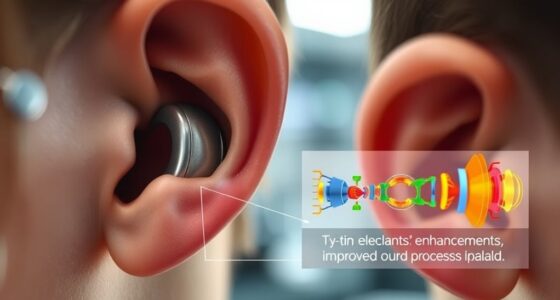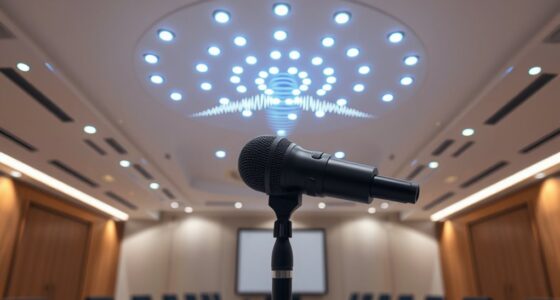Self-fitting algorithms can empower you with customized, seamless device adjustments that improve your experience and independence. They analyze your preferences and environment to make automatic changes, reducing manual effort. However, they also pose privacy risks by collecting sensitive data and can diminish your control if decisions are made without your input. To truly benefit, you need to understand how these systems work and how to manage them—if you continue, you’ll discover more about balancing empowerment and risk.
Key Takeaways
- Self-fitting algorithms personalize devices for better user experience but rely on extensive personal data, raising privacy concerns.
- They empower users with effortless customization and adaptive guidance, enhancing accessibility and control.
- Autonomous adjustments may override user preferences, risking reduced user autonomy and satisfaction.
- Data security and transparency are critical to prevent misuse, breaches, and maintain user trust.
- Balancing personalization benefits with privacy and control is essential to ensure these systems are empowering rather than risky.

Have you ever wondered how technology can personalize itself to fit your needs without constant human intervention? Self-fitting algorithms are revolutionizing the way devices adapt to you, whether it’s hearing aids adjusting to your environment or fitness apps tailoring workout plans. These algorithms analyze your input and automatically fine-tune settings, providing a seamless, personalized experience. But as much as this sounds convenient, it raises significant questions about privacy concerns and user autonomy.
Self-fitting algorithms personalize devices seamlessly but raise important privacy and user autonomy concerns.
When technology takes charge of customization, it collects a vast amount of data about your habits, preferences, and behaviors. This data is essential for the algorithms to learn and improve their recommendations, but it also puts your privacy at risk. You might wonder who has access to this information, how securely it’s stored, and whether it could be exploited or mishandled. These concerns aren’t just theoretical; breaches and misuse of personal data happen more often than you’d like to admit, making it imperative to understand the privacy implications of self-fitting systems.
At the same time, self-fitting algorithms can either empower or undermine your user autonomy. On one hand, they give you the ability to customize devices effortlessly, often providing step-by-step guidance or adjusting settings based on your feedback. This hands-free approach can make technology more accessible and easier to manage, especially for those who lack technical expertise. You’re in control of the outcome, with the algorithms acting as intelligent assistants that adapt to your unique needs.
However, on the flip side, these systems might also diminish your sense of control if they start making decisions without your explicit input or override your preferences. When algorithms make automatic adjustments based on their own interpretations, you might feel like your personal choices are being sidelined. This can be especially problematic if the algorithms are flawed or biased, leading to suboptimal results or even discomfort.
Ultimately, self-fitting algorithms walk a fine line between empowering users and risking overreach. They promise greater convenience and personalization, but they also demand greater vigilance regarding privacy and control. As these systems become more prevalent, it’s essential for you to stay informed about how your data is used and to ensure you retain some level of user autonomy. Recognizing the importance of color accuracy and how it can be affected by algorithms is crucial for maintaining a satisfying experience. Only then can you truly benefit from the potential of self-fitting technology without sacrificing your privacy or independence in the process.
Frequently Asked Questions
How Do Self-Fitting Algorithms Compare to Professional Audiologist Fittings?
You might wonder how self-fitting algorithms compare to professional audiologist fittings. These algorithms aim to improve personalization accuracy, often matching or surpassing professional results. They’re designed for ease, offering quick adjustments that can boost user satisfaction. While they can be effective, some users prefer expert guidance for complex needs. Ultimately, self-fitting algorithms provide a convenient alternative, but individual preferences and specific hearing requirements influence how well they work for you.
What Are the Potential Privacy Concerns With Self-Fitting Technology?
You might worry about privacy with self-fitting technology because it involves sharing your hearing data. While it offers convenience, there’s a risk if companies don’t prioritize data security, potentially exposing your personal information. Ensuring your user anonymity is protected is essential, so you should check how your data is stored and used. Being aware of these privacy concerns helps you make informed decisions about using self-fitting devices.
Can Self-Fitting Algorithms Adapt to Long-Term Hearing Changes?
You might wonder if self-fitting algorithms can handle long-term hearing changes. These algorithms aim for long-term adaptation, adjusting settings as your hearing stability shifts. While they’re designed to monitor and respond to hearing variations over time, their effectiveness depends on the technology’s sophistication. Properly calibrated, they can support ongoing hearing health. However, regular professional check-ups are still essential to guarantee ideal long-term adaptation and hearing stability.
Are Self-Fitting Devices Suitable for All Types of Hearing Loss?
Think of self-fitting devices as navigators guiding you through a complex journey. While they work well for many, they aren’t suitable for all types of hearing loss. You need to guarantee user safety and device reliability, especially if your condition is complex or progressive. Consult an audiologist for personalized advice, because relying solely on self-fitting technology might overlook unique needs, risking ineffective results or safety concerns.
What Are the Cost Differences Between Self-Fitting and Traditional Hearing Aids?
You’ll find that self-fitting hearing aids generally cost less than traditional ones, mainly due to reduced clinical visits and simplified manufacturing. This translates into significant cost savings and increased affordability options for users. While traditional hearing aids may include personalized fittings and ongoing support, self-fitting devices offer a more budget-friendly alternative without sacrificing basic functionality. If affordability is your priority, self-fitting options might be the smarter choice for your hearing needs.
Conclusion
Self-fitting algorithms put control in your hands, making tech more accessible and personalized. But as they adapt and learn on their own, they also pose risks—like misjudging your needs or compromising privacy. It’s a double-edged sword: empowerment versus uncertainty. While you gain convenience, you must also stay vigilant. Ultimately, embracing these tools means balancing trust with caution, knowing that while they can serve you better, they can also lead you astray if left unchecked.











